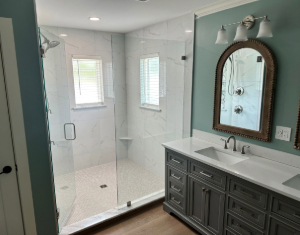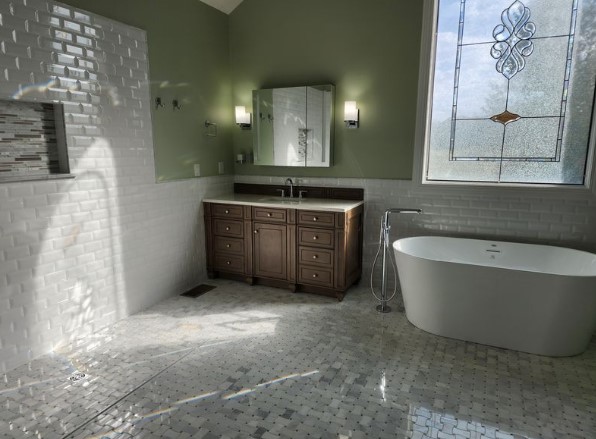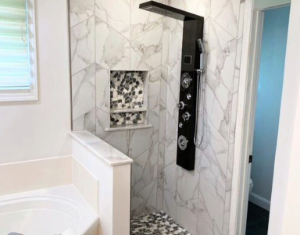There’s nothing more demoralizing than having to fix your own mistakes. It’s a fact the unprepared DIY tiler knows well.
The average American home as 9 unfinished DIY projects. And we bet that more than a few of those are down to mistakes made early in the process — or a lack of confidence. Learning what separates the pros and the amateurs can help you avoid some of the most common pitfalls the home DIY-er might fall into.
Tiling can be one of the most daunting DIY jobs out there. To pull it off, you need to know the 7 tiling mistakes the best installers don’t make.
1. Fail to Plan
As they say: “fail to plan, plan to fail”. We’re laying this one right at the beginning because that’s the stage where planning best pays off.
So take some time to look at the room and plan things out — in detail. Figure out your overall look, your tiling pattern, your bill of materials, and the order you’ll do the work.
Frontload time and effort into the planning phase if you want to avoid changing course or abandoning your ideas later. Give your ideas time to sit so you can spot flaws before you start sticking tiles to walls and floors.
Measure, plan, sketch, and don’t commit until you’re sure of your plan. You’ll thank yourself later.
2. Surfacing Problems
Failing to prep the surface to be tiled is one of the earliest major no-nos you can hit. You can set yourself up for problems by failing to scrub down walls before you start.
A bit of dirt might not seem like a big deal, but it’s all about the microscopic. At our level, dirt looks pretty flat. But Ant-Man could tell you all about the bumps and grooves that dirt actually consists of. And grease will also create a slick surface that will interfere with a strong bond.
And that’s a big deal because your tiles need to bond to a flat surface or you’ll end up with a weak adhesive hold. In turn, that means wonky tiles and warping as time goes on.
3. Breaking Bad
Take one down, smash it on the ground, 98 tiles left to go on the wall.
Breaking your tiles when you try to cut them is a quick way to waste money and time during a large tiling job. Redecorating is rarely cheap, so you need to avoid waste for cost-effective work.
Keeping your tiles in one piece isn’t difficult, but it does demand a little specialist knowledge. The ideal tool for tile cutting is a diamond wet saw — but they’re expensive to buy and even to hire.
One alternative is to use a score-and-snap tile cutter. It demands a little more finesse, but it’s also the cheaper option — if you can avoid breaking tiles, that is.
4. A Halfway (Done) House
If you’ve ever struggled to find a matching pair of socks or insert a USB drive the right way around the first time, then you know life is full of little frustrations. Things are no different in the tiling world.
Sometimes it seems like, no matter how well you planned things, you never have enough tiles. And there’s nothing more frustrating than getting most of the way through a job before you discover a shortage.
Run the numbers and run them again. Check and recheck your measurements. And overbuy, if you have to. Trust us, you’ll appreciate it later. It’s easier to get shot of spare tiles after the work is done.
5. Sight Unseen
Your tiling work isn’t just about what you can see. The behind-the-scenes work is as important.
We’re talking about two major things here: the underlayment for a tile floor, and the backer board for tiling in areas like bathrooms.
Your underlayment will keep your floor tiling level, which will prevent it from buckling or sagging over time. You’ll need a suitable surface under there if you don’t want to redo everything on the regular.
In wet areas like bathrooms, your backer board is essential. Without a backer board, moisture can seep around the edge of tiles, and you’ll soon have water where you don’t want the water to be.
6. I Am Grout
The general state of the grouting is a quick way to set the pros apart from the dabblers.
Professionals know to take their time to get an even grouting surface. A smaller area done carefully is more useful than a larger area done quickly. After all, you don’t want the grout drying before you can even start laying tiles.
A pro also knows to clean up excess grout as they go. Otherwise, the grout will dry, making it harder to tidy up your work at the end.
7. Don’t Trust Yourself
The first casualty of war is always the plan. And on the bathroom battlefield, you’re sure to suffer a few SNAFUs. But to torture this metaphor, effective scouting can turn the tide of battle.
Take a step back and look at your handiwork often. Better yet, get someone else to look at it. When you’re deep in the tiling vibe, you may miss obvious mistakes. Our brains aren’t great at critical thinking when we go on autopilot.
Tiling mistakes can be a pain to fix when left to sit. The earlier you catch them, the easier it’ll be to put them right. So slow down and check your work as you go. If you’re lucky, you might catch them before the rest of the family has a chance to point and laugh — if not, they may be laughing for years to come.
Cracking It: Avoiding Tiling Mistakes
With these tips, you should be able to crack the tiling problem — without cracking your tiles. Just take your time to get it right, as prevention will always be better than the cure. You won’t thank yourself for a rush job.
Still not feeling confident? Contact us today to bring in the professionals.











